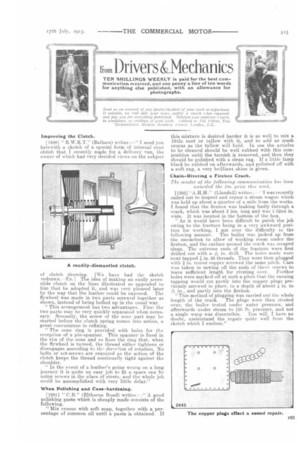ED. Drivers &Mechanics TEN SHILLINGS wEettLY is paid for the
Page 45

If you've noticed an error in this article please click here to report it so we can fix it.
best communication received, and one penny a line of ten words for anything else published, with an allowance for photographs.
Send is an account of any special incident of your work or experience. If suitable, we w1l edit your notes, suPPly a sketch when required, and pay you for everything published, Mention your employer's name, In confidence, as evidence of good piith. Address to The Editor, TEL COMM E RCI AL MOTOR, Rosebepy Aveous, I.ondoi, E.G.
Improving the Clutch.
[1290] "R,W.R.T." (Balham) writes —"I send you herewith a sketch of a special form of internal cone clutch that I recently made for a delivery van, the owner of which had very decided views on the subject of clutch dressing. [We have had the sketch redrawn_—En.] The idea of making an easily accessible clutch on the lines illustrated so appealed to him that he adopted it, and was very pleased later by the way that the leather could be exposed. The flywheel was made in two parts screwed together as shown, instead of being bolted up in the usual way. "This arrangement has two advantages. First the two parts may be very quickly separated when necessary. Secondly, the screw of the cone part may be started before the clutch spring comes into action, a great convenience in refixing. " The cone ring is provided with holes for the reception of a pin-spanner. This spanner is fixed in the rim of the cone and so fixes the ring that, when the flywheel is turned, the thread either tightens or disengages according to the direction of rotation. No bolts or set-screws are required as the action of the clutch keeps the thread continually tight against the shoulder.
" In the event of a leather's going wrong on a long journey it is quite an easy job to fit a spare one by using screws in the place of rivets, and the whole job could be accomplished with very little delay."
When Polishing and Case-hardening. 112911 " C.B." (Elthorne Road) writes: ---" A good polishing paste which is cheaply made consists of the following.
"Mix crocus with soft soap, together with a percentage of common oil until a paste is obtained. If this mixture is desired harder it is as well to mix a little suet or tallow with it, and to add as much crocus as the tallow will hold. In use the articles to be cleaned should be well rubbed with this composition until the tarnish ie removed, and then they should be polished with a clean rag. If a little lamp black be rubbed on afterwards, and polished off with a soft rag, a very brilliant shine is given.
Chain-Riveting a Firebox Crack.
The sender of the following communication has been awarded the los. prize this week.
[1292] "A.S.11." (llandaff) writes : -"I was recently called out to inspect and repair a steam wagon which was held up about a. quarter of a mile from the works. I found that the firebox was leaking badly through a crack, which was about 2 ins, long and was 132nd in. wide. It was located in the bottom of the box.
" As it would have been difficult to patch. the job owing to the fracture being in a very awkward position for working, I got over the difficulty in the following manner. The boiler was jacked up from the smokebox to allow of working room under the firebox, and the surface around the crack was scraped clean. The extreme cads of the fracture were first drilled out with a. t'd in. drill. The holes made were next tapped in. 26 threads. They were then plugged with in. round copper screwed the same pitch. Care was taken in sawing off the ends of these screws to
leave sufficient length for riveting over. Further holes were marked off at such a pitch that the ensuing tapping would cut, partly into the copper plugs previously screwed in place, to a depth of about in. to -N in., and partly into the firebox. " This method of plugging was carried out the whole length of the crack. The plugs were then riveted over, the boiler tested ender water pressure, and afterwards under steam to 150 lb. pressure, and not a single weep was discernible. You will. I have no doubt„ understand the repair quite well from the sketch which I enclose,"














































